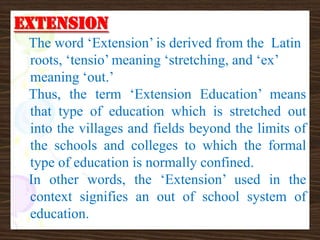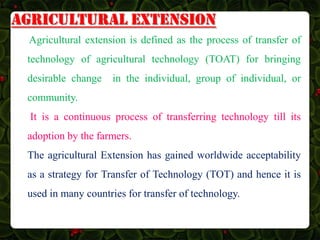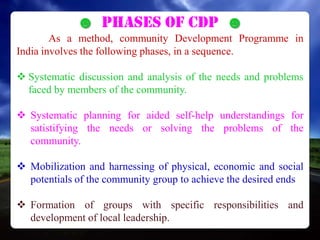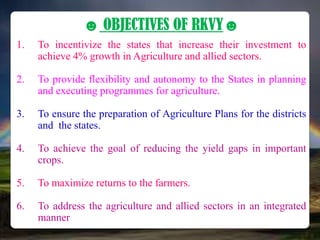Dimensions of Agricultural Extension: Prepaired by Basvraj L Pisure
- 2. Seminar on DIMENSIONS OF AGRICULTURAL EXTENSION Presented By Mr. Pisure Basvraj Limbraj Reg.No: 2010A/82ML Seminar Incharge Dr. D. D. Suradkar Assistant Professor Department Of Extension Education College Of Agriculture, Latur Marathwada Krishi Vidyapeeth, Parbhani
- 3. ☻ Agriculture is the backbone of Indian Economy. Even after five decades of planning, agriculture continues to remain the most dominant sector of the economy. ♠ Agricultural Extension is the key mechanism in the agricultural development. Agricultural Extension Education includes all activities and programmes directed towards the development of the rural people. ♣ Newer technologies for increasing agricultural production are now becoming available at much faster rate. The new technologies should reach the right people in the right and appropriate time. A well- developed extension network is the prime necessity to meet the above need.
- 4. Cont… The successful implementation of the erstwhile programmes in our country has helped us to reach self sufficiency in the food grain production But in developed countries 80-85 per cent of agricultural findings reach farmers in the required time, but in our country, it is only 15-20 per cent. Successful planning and diffusion of new technologies not only requires efforts, but also requires a combination of administrative, managerial and communication skills. Towards understanding the gamut of the practice of extension in agricultural development, this seminar provides a view of the various aspects of extension efforts.
- 5. OBJECTIVES To understand the concept of extension education. To know the dimensions of Agricultural Extension Education. To know about rural development and different rural development programmes in India from independence and before independence. To know the role and importance of Extension Education in Agriculture. To know current issues and schemes for rural development.
- 6. Extension The word „Extension‟ is derived from the Latin roots, „tensio‟ meaning „stretching, and „ex‟ meaning „out.‟ Thus, the term „Extension Education‟ means that type of education which is stretched out into the villages and fields beyond the limits of the schools and colleges to which the formal type of education is normally confined. In other words, the „Extension‟ used in the context signifies an out of school system of education.
- 7. Education Education may be defined as the production of desirable changes in human behaviour. The aim of education is to influence the people to make those desirable changes in their behaviour that contribute to better living. These changes occur mainly in the following four area, namely knowledge, attitude, skills and aspiration (KASA). There are three types of education 1. Formal education. 2. Informal education. 3. Non-formal education.
- 8. Agricultural Extension Agricultural extension is defined as the process of transfer of technology of agricultural technology (TOAT) for bringing desirable change in the individual, group of individual, or community. It is a continuous process of transferring technology till its adoption by the farmers. The agricultural Extension has gained worldwide acceptability as a strategy for Transfer of Technology (TOT) and hence it is used in many countries for transfer of technology.
- 9. Objectives of Extension Education 1. To assist people to discover and analyze their problems and identify there felt needs. 2. To develop leadership among people to help themselves in organizing groups to solve their problems. 3. To disseminate research information of economical and practical importance in a way people be able to understand and use. 4. To assist people in mobilizing and utilizing resources which they have and which they need from outside. 5. To collect and transmit feedbacks information for solving management problems. 6. To ensure the development of people. This is the fundamental objective of extension education.
- 10. Dimensions Of Agricultural Extension From the above discussion the following dimensions of agricultural extension can be identified. 1. Agricultural extension is a professional method where professional extension workers are employed. 2. It is non-formal educational process in which emphasis is given on technology transfer. 3. It includes behavioural changes in farmers. 4. It has emphasis on increased income from two courses namely, production of double/multiple cropping and increased productivity by introduction of new technology like seeds, fertilizers etc.
- 11. Cont… 5. It includes firm linkage with research for solving farmers problems. This includes transfer of latest technological innovations from research to farmers and farmers feedback to research. 6. It ensures adequate and timely supply of inputs. 7. It uses proven methods of communication for speeding up the process of adaption and diffusion of innovations. Thus, extension is mainly related to the rural development and for accomplishing this objective there are different projects and schemes were introduced by GOI before and after independence for increasing rural development
- 12. ☻Rural Development ☻ Rural Development is a strategy designed to improve the economic and social life of rural poor. It is a dynamic process, which is mainly concerned with the rural. These includes agricultural growth, putting up of economic and social infrastructure , fair wages, as well as housing for landless, village planning, public health , education, functional literacy, communication and other aspects. Rural development programmes should aim at improving the lot of poor people by creating new productive assets for them. The emphasis should be to help people in order to help themselves.
- 13. ☻Developmental Programmes☻ Different Development programmes are divided in to two eras on their launching years viz., A) Pre-independence era B) Post-independence era A) Pre-independence era Some social workers and thinkers were moved by the misearies of the rural people. They were inspired by profound humanism. These past experiments were helpful in framing the future rural development programmes and hence are discussed in great detail.
- 14. Sr.No Name of Activity or Starting Name of the Remarks Programme year worker 1. Co-operative 1904 F. Nicholson Individually movement financed 2. Gurgaon Project 1920 F.L. Brayne Concept of (Haryana) Village Guide 3. Sevagram (M.S) 1920 M.K. Gandhi To spread Charakha & Khadi 4. Sriniketan (W.B) 1921 R.Tagore Concept of VLW 5. Marathandum 1921 Spencer Hatch With the help of project (Kerala) YCMA 6. Etawah Pilot Project 1948 Albert Mayer 7. Nilokheri 1948 Shri. S.K. Dey Created a Experiment ‘Mazdoor Manzil’ 8. Firka Develpoment 1950 Madras Govt. Promoting Khadi Project (Prakashan) & village industries
- 15. ♦ COMMUNITY DEVELOPMENT PROGRAMME ♦ Community Development Programme launched in 1952. Community Development is a method of assisting the village people in desiring and achieving certain improvements in their life and ways of living. The community development involves a change or modification or development in the motives, attitudes, habits and practices of thousands of people in their individual, family and community life. This change amount to “ a cultural change through cultural development” of the people.
- 16. CD assumed high propriety after independence • 1952 GOI launched 55 CD projects each covering 300 villages popn. of 30,000 • 1953 National Extension Service project – similar objective, to cover larger areas • Began as a comprehensive development effort to rebuild rural life and livelihood • CD blocks treated as admin. units for planning and devt. with separate budget. • By first 5yr plan (1952-57) – 1114 blocks covering 163,000 villages were operation • By the sixties CDP covered the entire country • Economic progress was core objective • CDP was the main programme until the 3rd 5 Yr plan. • Objective was to create conditions for high living standards and upliftment of rural poor
- 17. Implementation Facets of CDPs Headed by a block development officer BDO assisted by eight Extension Officers One each for agriculture, animal husb, Panchayat, co- operation rural industries, rural engineering, social education, women and child welfare VLV – BDO – Dist. Collector – Devt Comssioner– Planning Commssion Govt. officials prepared plan under Planning Commission. Initially no chance for community to demand any facility to solve their problem
- 18. ☻Objectives of CDP☻ Achievement of increased production through the application of scientific knowledge to the rural occupations like agriculture, animal husbandry, cottage, industries etc. Provision of opportunities for the full employment to the under employed and unemployed population. Creation of more amenities mainly through the efforts of the concerned communities, by making them devote their unutilized energies and spare time. Development of self-reliant and harmonious village communities.
- 19. ☻ Phases of CDP ☻ As a method, community Development Programme in India involves the following phases, in a sequence. Systematic discussion and analysis of the needs and problems faced by members of the community. Systematic planning for aided self-help understandings for satistifying the needs or solving the problems of the community. Mobilization and harnessing of physical, economic and social potentials of the community group to achieve the desired ends Formation of groups with specific responsibilities and development of local leadership.
- 20. ♦ National Extension Service ♦ It was launched on 02 October, 1953 in the areas, which were not covered by CDP. Objectives: To integrate the efforts of all the developmental departments at the village level with a view to provide quick help and service to the rural people. To intensify the impact of the extension service on village with a view to improve all aspects of village life, to change the outlook of the farmer and to mobiles local initiative and resources for the betterment of rural conditions.
- 21. •Panchayat Raj System• 1957 Balwant Rai Mehta Commitee appointed to suggest measures to remove obstacles from CDP Three tier system of local Govt. – Gram Panchayat (Village level), Panchayat Samiti (Block level), Zilla Parishad (District level) The three-tier system aimed to link Govt. and elected representative. To decenterlise decision making To shift decision making closer to people and encourage their participation To place Bureaucracy under people‟s control
- 22. Specific Objectives of Panchayat Raj System Assistance to the economically weaker sections of the community. Cohesion and cooperative self help in the community. Development of cooperative institutions. Development of local resources including the utilization of manpower. Production in agriculture as the highest priority in planning. Progressive dispersal of authority and initiative both vertically and horizontally with special emphasis on the role of voluntary organizations. Promotion of rural industries. Understanding and harmony between the people‟s representatives and people servants through comprehensive training/education and a clear demarcation of duties and responsibilities.
- 23. Agriculture Development Programmes There are so many important and successful programmes are implemented by the Govt. for agriculture development including. Some important programmes are listed below. Sr.No. Year Name of programme 1. 1948 GMFC- Grow More Food Campaign 2. 1952 CDP- Community Development Programme 3. 1953 NES- National Extension Service 4. 1960 IADP- Intensive Agricultural Devlpt. Progrm. 5. 1964-65 IAAP- Integrated Agril. Area Programme 6. 1966-67 HYVP- High Yielding Verities Programme 7. 1970 DPAP- Draught Prone Area Programme Cont….
- 24. 8. 1970 DFAP- Dry Farming Area Programme 9. 1971 ICDP- Integrated Cotton Development Programme 10. 1971 SFDA- Small Farmers Development Agency 11. 1974 T&V- Training and Visit System 12. 1974 KVK - Krushi Vigyan Kendra 13. 1975 CADP- Command Area Development Programme 14. 1978 IRDP- Intergraded Rural Development Programme 15. 1978 DDP - Desert Development Programme 16. 1979 LLP- Lab-to-Land Programme 17. 1979 NARP -National Agricultural Research Project 18. 1979 TRYSEM-Training of Rural Youth for Self Employment 19. 1981 RLEGP- Rural Landless Employment Guarantee Progrm. 20. 1982 DWCRA- Develpt of Women and Children in Rural Areas 21. 1989 JRY -Jawahar Rojgar Yojana 22. 1998 NATP -National Agricultural Technology Project Cont….
- 25. 23. 1997 GKY- Ganga Kalyan Yojana 24. 1998 ATMA -Agricultural Technology Management Agency 25. 1999 SGSY- Swarnjayanti Gram Swarojagar Yojana 26 2000 PMGSY- PM Gram Sadak Yojana 27. 2001 SGRY- Sampoorna Gramin Rojgar Yojana 28. 2005 BNY- Bharat Nirman Yojana 29. 2005 NAIP -National Agricultural Innovation Project 30. 2006 MGNREGA- Mahatma Gandhi National Rural Employment Guarantee Act 31. 2011 NFSB- National Food Security Bill
- 27. IRDP- Intensive Rural Development Programme IRDP introduced in 1979 for rural poor and weaker sections of society . Earlier Programmes relied on delivery systems which suppressed self-reliance Shift from community development to schematized planning. IRDP is a centrally sponsored scheme implemented by DRDAs at the district level. The centre and the states fund the scheme on a 50:50 basis.
- 28. Objectives of IRDP The main objectives of IRDP are creating assets, employment, increased income, removal of poverty and maintaining inequality. Rural poverty alleviation. The guideline given to achieve the objectives includes: 1. Job opportunities must be created through the application of science and technology in making optimum use of existing local resources. 2. The programme must be simple enough to operate and must be economically viable to ensure quick returns to the beneficiaries. 3. IRDP aimed at provision of assets to the identified poor in the form of govt. subsidy and bank credit at reasonable rate of interest.
- 29. ☻LAB TO LAND PROGRAMME☻ Launched in 1979 By ICAR on completion of 50 years of their establishment. OBJECTIVES : To study and understand the background and resources of the selected farmers. To assists the farmers in utilization of their available resources. To guide and help the farmers in adopting improved technologies. To organize training programmes and other extension activities. To make a functional relations and linkages with scientists and institutions for future guidance, advisory service and help.
- 30. ♦ SWARNJAYANTI GRAM SWAROZGAR YOJANA (SGSY) ♦ Swarnjayanti Gram Swarojagar Yojana is centrally sponsored which came into effect from 01 April,1999 Scheme basically emphasizes on self-employment. Scheme covers all aspect of self- employment like capacity building, subsidy, and infrastructure facility, and credit, skill up gradation, insurance and marketing. SGSY is combination of 6 earlier programmes namely TRYSEM, DWCRA, SITRA and GKY, besides MWS. SGSY is financed on 75:25 cost sharing base between Centre and State Governments.
- 31. Targed groups Families Below the Poverty Line (BPL) in rural areas constitute the target group of the SGSY. Within the target group, special safeguards have been provided to vulnerable sections, by way of reserving 50% benefits for SCs/STs, 40% for women and 3% for disabled persons. The Projects may involve different strategies to provide long term sustainable self employment opportunities either in terms of organization of the rural poor, provision of support infrastructure, technology, marketing, training etc. or a combination of these.
- 32. ☻Sampoorna Grameen Rozgar Yojana (SGRY)☻ Launched on 25th September 2001 Objectives of providing additional wage employment ensuring food security while creating durable community, social & economic infrastructure and assets in the rural areas. SGRY along with National Food for Work Programme (NFFWP) have been subsumed in the NREGA districts
- 33. ♣ Pradhan Mantri Gram Sadak Yojana (PMGSY) ♣ Launched December, 2000 100% centrally sponsored scheme to provide connectivity to unconnected habitations Road connectivity to all habitations with a population of thousand (500 in case of hilly or tribal areas) with all weather roads by 2009 Will lead to rural employment opportunities, better access to regulated and fair market, better access to health, education and other public services. Bridge the rural-urban divide and pave the path of economic growth.
- 34. ☻MAHATMA GANDHI NATIONAL RURAL EMPLOYMENT☻ GUARANTEE ACT (MGNREGA) FEATURES : The NATIONAL RURAL EMPLOYMENT GUARANTEES ACT- 2005” It is also known as NREGA. NREGA Launched on 2nd February 2006 as a momentous initiative towards pro-poor growth. The National Rural Employment Guarantee Act, 2005 (NREGA) guarantees 100 days of employment in a financial year to any rural household whose adult members are willing to do unskilled manual work. NREGA renamed as MGNREGA on 2 October, 2009.
- 35. Cont… Work within 15 days of demand. Compensation under Payment of Wages act, 1936 for delayed payment of wages. The shelf of projects for a village will be recommended by the gram sabha and approved by the Zilla Panchayat. At least 50% of works will be allotted to Gram Panchayats for execution Permissible works predominantly include water and soil conservation, afforestation and land development works A 60:40 wage and material ratio has to be maintained. No contractors and machinery is allowed.
- 36. Rashtriya Krishi Vikas Yojana (RKVY)
- 37. On August 16, 2007, the government approved the Rashtriya Krishi Vikas Yojana (RKVY) with the allocation of Rs. 25,000 crore for the eleventh five year plan. The RKVY is a flagship scheme of the government. The areas of focus in RKVY are seeds, fertilizers, IPM, testing laboratories, horticulture, farm mechanization, extension, crops, marketing and cooperatives. Besides, state have stepped of activities in the animal husbandry, dairy and fisheries sectors. The RKSY is mainly related to the overall development of the agriculture sector in India.
- 38. ☻ OBJECTIVES OF RKVY☻ 1. To incentivize the states that increase their investment to achieve 4% growth in Agriculture and allied sectors. 2. To provide flexibility and autonomy to the States in planning and executing programmes for agriculture. 3. To ensure the preparation of Agriculture Plans for the districts and the states. 4. To achieve the goal of reducing the yield gaps in important crops. 5. To maximize returns to the farmers. 6. To address the agriculture and allied sectors in an integrated manner
- 39. Basic features of the RKVY 1. It is a State Plan scheme. 2. The eligibility of a state for the RKVY is contingent upon the state maintaining or increasing the State Plan expenditure for Agril. & Allied Sector. 3. The base line expenditure is determined based on the average expenditure incurred by the State Government during the three years prior to the previous year. 4. The list of allied sectors is as indicated by the Planning Commission. 5. The preparation of the district and State Agriculture Plans is mandatory. 6. Encourages convergence with other programmes such as NREGS, SGSY, BRGF, etc. 7. Pattern of funding is 100% Central Government Grant.
- 40. ☻ BHARAT NIRMAN YOJANA ☻ Launched on December 16, 2005. Under Bharat Nirman, developmental works are undertaken in the areas of irrigation, road, rural housing, rural water supply, rural electrification and rural telecommunication connectivity. Three of the goals of Bharat Nirman fall within the mandate of the Min. of Rural Development: • rural connectivity • rural housing • rural water supply Specific targets so that there is accountability in the progress of this initiative. Bharat Nirman an effort to unlock rural India's growth potential and key for ushering a new era 'National Common Minimum Programme' (NCMP)
- 41. NATIONAL FOOD SECURITY BILL This bill passed in 2011 Why National Food Security Bill is important ? According to Global Hunger Index published by International Food Policy Research Institute, 22 % of Indian population is undernourished. 44.4 % children below age of 3 years are underweight where as 33% of women in the age group 15 year to 49 years have BMI below normal level. These facts clearly give the necessity of food security. Hence the bill is proposed for providing minimum quantity of food grain per month to BPL families through public distribution system.
- 42. Provisions 75% of the rural population and 50% of Urban population will be covered under the bill. These families will be identified by government local bodies and women will be treated as head of the household. Households will be classified as Priority households and General households. Establishment of Central Food Security Fund, State Food Security Allowance Fund. Establishment of national and state food commission. Mid-day Meal Scheme has been brought under the bill. Pregnant women, children in the age group of 0-6 years, also those below 14 years and out of school, homeless, migrants and disaster affected persons have special provisions.
- 43. ☻ Conclusion ☻ Extension Education plays a vital and major role in agriculture and rural development. Dimensions of Extension Education are mainly related with the overall rural and agriculture development and poverty alleviation. Rural development is very important for any country for well growth it. Government launched so many and successful schemes or programmes in our country before and after independence.
- 44. Cont… Presently, Indian extension system has broadened its horizons to make more meaningful services to farmers, farm women and rural youths. The rather is no more an effort limited to transfer technology to the farmers, rather it has been thrusting to add new dimensions of providing market, lending, insurance, diagnosis and advice related services with a collaborative efforts of public, private and farmers organizations.













































